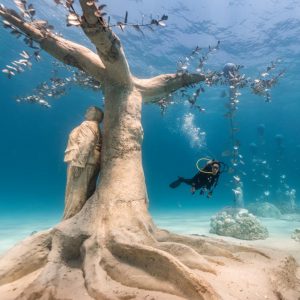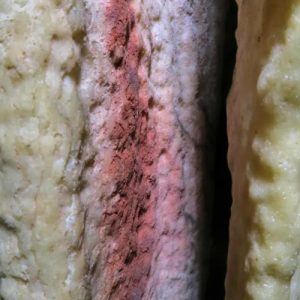Link About It: This Week’s Picks
Underwater art, discoveries in Spanish caves, Black architects’ impact on NOLA and much more

Black Architects’ History of “Immeasurable Impact” on New Orleans
 “Before the Civil War,” Architectural Digest reports, “New Orleans had the largest group of free people of color in the United States.” Though they have largely been omitted from history books, this persevering, prosperous group of citizens contributed substantially to the architectural development and present-day identity of the city—influencing stucco Creole cottages and larger town houses, which are still visible. Today, the Free People of Color Museum chronicles stories like these, as told by descendants of those that shaped the city’s history. Read more about the the prominent Black architects and their contributions at Architectural Digest.
“Before the Civil War,” Architectural Digest reports, “New Orleans had the largest group of free people of color in the United States.” Though they have largely been omitted from history books, this persevering, prosperous group of citizens contributed substantially to the architectural development and present-day identity of the city—influencing stucco Creole cottages and larger town houses, which are still visible. Today, the Free People of Color Museum chronicles stories like these, as told by descendants of those that shaped the city’s history. Read more about the the prominent Black architects and their contributions at Architectural Digest.
Image courtesy of Andrew LaMar Hopkins
The Inaugural Gallery Weekend Los Angeles + Felix Art Fair 2021
 From 28 July to 1 August, more than 80 Los Angeles galleries united—under the organizing entity Gallery Platform LA—for an inaugural weekend of events (arranged by neighborhood) that aimed to make the city’s art scene more accessible. Coinciding with the milestone event, Felix Art Fair (representing 29 galleries) returned to the Hollywood Roosevelt Hotel for its third iteration. The pioneering fair once again allowed guests to find works by emerging artists tucked inside hotel rooms and hung in unexpected areas, often lending fresh context. Read more about these events and see plenty of highlight imagery at Hyperallergic.
From 28 July to 1 August, more than 80 Los Angeles galleries united—under the organizing entity Gallery Platform LA—for an inaugural weekend of events (arranged by neighborhood) that aimed to make the city’s art scene more accessible. Coinciding with the milestone event, Felix Art Fair (representing 29 galleries) returned to the Hollywood Roosevelt Hotel for its third iteration. The pioneering fair once again allowed guests to find works by emerging artists tucked inside hotel rooms and hung in unexpected areas, often lending fresh context. Read more about these events and see plenty of highlight imagery at Hyperallergic.
Image of Nevine Mahmoud at M + B, by Samanta Helou Hernandez for Hyperallergic
Jason deCaires Taylor’s Underwater Gallery in Cyprus
 Named the Museum of Underwater Sculpture Ayia Napa, British artist Jason deCaires Taylor’s submerged sculpture park in Cyprus is the first underwater gallery in the Mediterranean. Located just off Pernera Beach in Ayia Napa (on the southeast coast of Cyprus), the museum consists of 93 artworks, all of which appear as trees, people or a hybrid of the two—exploring “the relationship between man and nature.” Not only do the artworks aim to draw attention to the depletion of marine life, but they will also provide food and shelter for animals. Read and see more at The Guardian.
Named the Museum of Underwater Sculpture Ayia Napa, British artist Jason deCaires Taylor’s submerged sculpture park in Cyprus is the first underwater gallery in the Mediterranean. Located just off Pernera Beach in Ayia Napa (on the southeast coast of Cyprus), the museum consists of 93 artworks, all of which appear as trees, people or a hybrid of the two—exploring “the relationship between man and nature.” Not only do the artworks aim to draw attention to the depletion of marine life, but they will also provide food and shelter for animals. Read and see more at The Guardian.
Image courtesy of Jason deCaires Taylor/Musan
Spanish Cave Reveals More Evidence Neanderthals Made Art
 Following a recent discovery in Germany, more evidence that Neanderthals created art, something that had long been rebuffed, has been revealed in Spain. These archaic humans—who existed 2.6 million to 11,700 years ago—were believed to be “unsophisticated and brutish,” but painted stalagmites in Ardales have been newly analyzed and the “composition and placement of the pigments were not consistent with natural processes—rather, the pigments were applied through splattering and blowing.” The paintings date back over 60,000 years and findings add “to increasing evidence that Neanderthals…were not the boorish relatives of Homo sapiens they were long portrayed to be.” Read more at The Guardian.
Following a recent discovery in Germany, more evidence that Neanderthals created art, something that had long been rebuffed, has been revealed in Spain. These archaic humans—who existed 2.6 million to 11,700 years ago—were believed to be “unsophisticated and brutish,” but painted stalagmites in Ardales have been newly analyzed and the “composition and placement of the pigments were not consistent with natural processes—rather, the pigments were applied through splattering and blowing.” The paintings date back over 60,000 years and findings add “to increasing evidence that Neanderthals…were not the boorish relatives of Homo sapiens they were long portrayed to be.” Read more at The Guardian.
Image courtesy of Joao Zilhao/ICREA/AFP/Getty Images
NYC’s New Skaters Are Creating Safe + Supportive Communities
 This summer, writer Jazmine Hughes and photographer Lanna Apisukh—the former a skateboarding rookie; the latter a tenured skater—visited parks in NYC to meet “The New Skaters.” These skaters—essentially not the white, straight, cis men who have dominated the sport professionally, personally and publicly—are building “new versions of skate communities, bringing together women, trans and nonbinary skaters, as well as skaters of color.” For newcomers and underrepresented individuals, the world of skateboarding can be intimidating at best, but these groups (many of which are being forged on social media) are creating safe, supportive and playful spaces. As Hughes writes, “Organizations like Quell, Late Skate, Sk8 Babes and Skate Like a Girl hold skate events, or ‘clinics,’ with the goal of creating a space for both new and old skaters to find community, as well as supporting the habit, by teaching tricks or providing opportunities to trade gear. For some, the new sense of belonging has extended beyond the sport.” Read more at The New York Times.
This summer, writer Jazmine Hughes and photographer Lanna Apisukh—the former a skateboarding rookie; the latter a tenured skater—visited parks in NYC to meet “The New Skaters.” These skaters—essentially not the white, straight, cis men who have dominated the sport professionally, personally and publicly—are building “new versions of skate communities, bringing together women, trans and nonbinary skaters, as well as skaters of color.” For newcomers and underrepresented individuals, the world of skateboarding can be intimidating at best, but these groups (many of which are being forged on social media) are creating safe, supportive and playful spaces. As Hughes writes, “Organizations like Quell, Late Skate, Sk8 Babes and Skate Like a Girl hold skate events, or ‘clinics,’ with the goal of creating a space for both new and old skaters to find community, as well as supporting the habit, by teaching tricks or providing opportunities to trade gear. For some, the new sense of belonging has extended beyond the sport.” Read more at The New York Times.
Image courtesy of Lanna Apisukh/The New York Times
Link About It is our filtered look at the web, shared daily in Link and on social media, and rounded up every Saturday morning. Hero image courtesy of Jason deCaires Taylor/Musan











